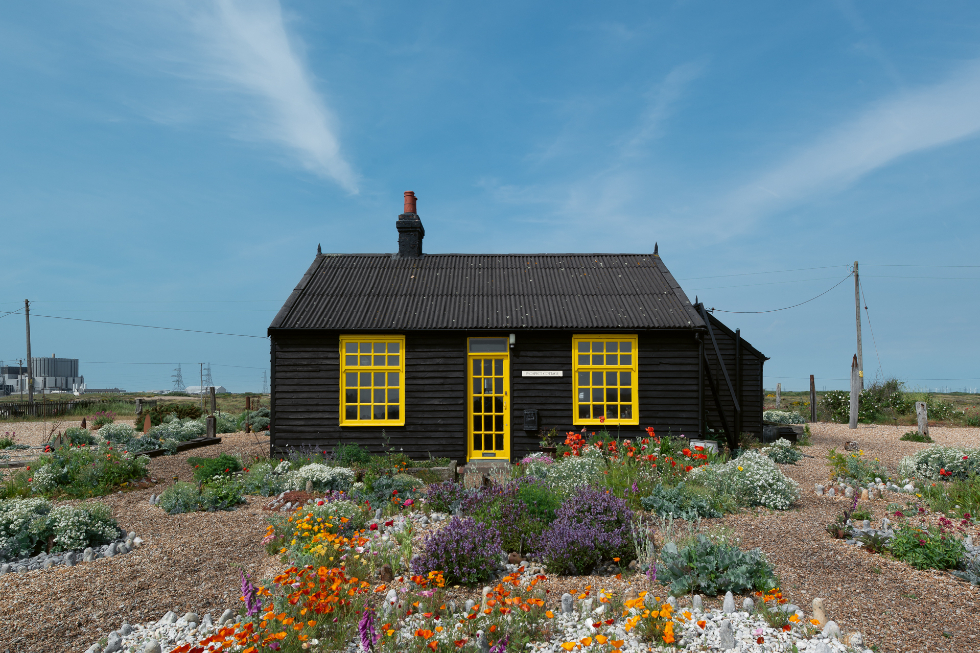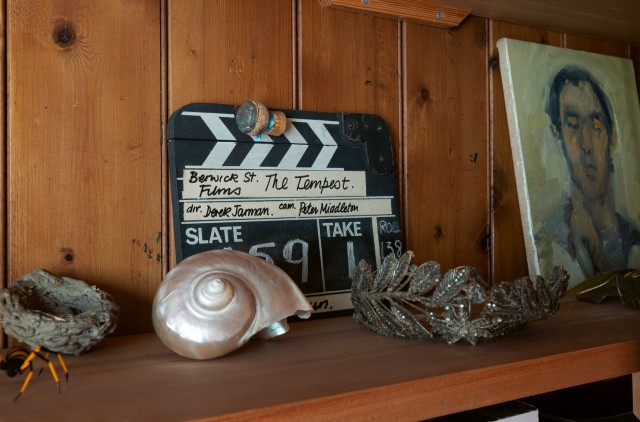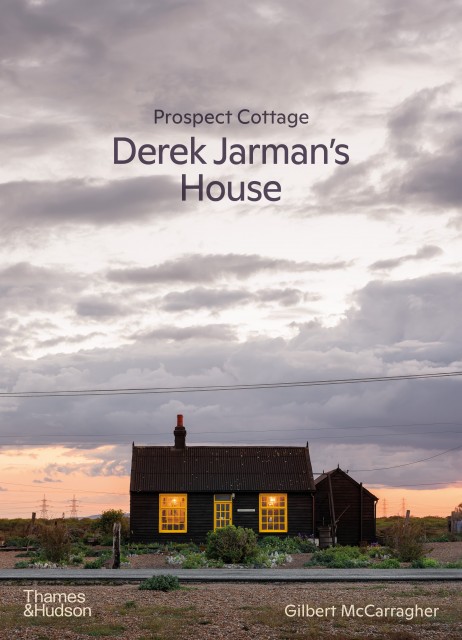Prospect Cottage: Gilbert McCarragher Photographs Derek Jarman’s House

In an exclusive extract from his new book with Thames & Hudson, on Derek Jarman’s famous coastal cottage, top photographer Gilbert McCarragher speaks movingly about what an artist’s home represents to those who are left behind to care for it – and how one might document its artwork, artefacts and atmosphere for posterity…
It had been two weeks since Keith Collins had turned the key for what would be the last time in the lock of Prospect Cottage, the home he shared with artist and filmmaker Derek Jarman until Derek’s death in 1994.
Keith and Derek were not lovers, I am told. Keith had in the past joked that Derek was too old for him, and that he had always been too old for Derek. That didn’t stop them living together and over the course of eight years forming an essential companionship. In an interview a year before his death, Derek described theirs as the best relationship of his life.
I let myself into Prospect and looked around. Keith’s freshly washed shirt and towels, now two weeks dry, waited patiently to be neatly folded and put away. A different fate awaited them now that Keith was not coming back. I wondered whether they would become part of the record of the cottage’s past, like Derek’s blue worker’s overalls, carefully folded and neatly stacked on his work bench in the studio, themselves freshly laundered by Keith twenty-four years prior.
I spotted a note from Derek to Keith engraved on the bathroom door. One of many around the house, it was addressed to ‘Hinney Beast’ – Derek’s affectionate nickname for Keith, often abbreviated by Derek to simply ‘H.B.’
The familiar words read to me as a reminder that I was not supposed to be there. I felt that my presence was like another of the countless sets of eyes that had peered through the yellow-framed windows of the cottage over the years; although unlike the others, I peered from the inside.
About fifteen boxes of books that Keith had been in the process of sorting through just a fortnight earlier sat on the floor of the studio, awaiting shelves that would now never be built.

The house was, of course, spotless despite these few things. Keith was obsessive when it came to cleanliness. ‘You can lick the bowl of the toilet it’s so clean’, he once joked when describing his meticulous domestic hygiene routine. He would not ordinarily have wanted the house to be seen like this. But things had moved very quickly in the preceding two weeks.
A friend and neighbour in Dungeness, Keith had, a few days earlier, been unexpectedly hospitalized with a previously unknown brain tumour. I was allowed to see the cottage in this state, as a more ordinary home, in order to create a photographic record of its contents. I was not there as a guest who had called by for tea, but as a part of the preparations for what seemed likely to come.
This was the first time I had been alone in the cottage. It was oddly quiet. There was no music coming from the garden room, the usual background sound to my visits.
The stillness of the space and the circumstances of my presence left me feeling a little unsure – apprehensive, even. Simple thoughts of ‘Where to start?’ and ‘What next?’ amplified themselves in the silence. Some grew in intensity, becoming ‘What next … for Keith?’, then ‘What next … for this place?’
It was not, I expect, the first time such questions had been asked in the vicinity of this house.
When Derek died from an AIDS-related illness in February 1994, I gather that Keith shut himself away in the cottage for a while. After a time, Ken Thomas, one of the local fishermen, knocked at Keith’s door to check on him. He told Keith they needed another set of hands aboard his fishing boat, adding that if he was to take the job on then he needed to pull himself together. ‘There’s no point moping around in the house for the rest of your life’, are the words said to have been used. They may sound the uncaring words of an old salt, but knowing Ken as I do, I have no doubt it was his carefully considered way of reaching out to someone obviously adrift; a means of encouraging Keith to swim towards a line thrown nearby.

In the weeks and months that followed, I understand that Keith took completely to seafaring life.
He turned to tales of his time ‘out fishing’ when later talking about the period after Derek’s death, joking about the perils of having to poo overboard when at sea. Keith’s fondness for a tall tale occasionally made it difficult to gauge quite where the truth in some of those stories lay, especially as he often spoke with a mischievous glint in his eye. But there was one constant in his accounts: Keith maintained that his time on the boat and the love and support of the Thomas family were the things that saved him from his own grief after Derek’s death.
As I looked around the house and thought about how best to capture the elements I needed to, a sinking feeling set in. It dawned on me that I might never again be able to just drop by for a chat. Keith might not be coming back to tell me another story about some artwork or artefact in the house.
Keith had laboured at Prospect Cottage in the years that followed Derek’s death, trying to preserve not only what was physically there, but also the memories that it represented. Whether he did so to find pleasure in memory or to deal with the pain of loss was never entirely clear to me. The drifting tension between the two seemed present in some advice he had given to me a few years earlier.
Dropping by my home one day, Keith found me feverishly polishing the brass lining of my window shutters. He told me matter-of-factly that I needed to stop, warning me that I was only creating a rod for my own back. He told me it would be better if I stopped fighting the inevitable and let the house do its own thing.
I wondered then whether Keith’s words came from a genuine belief in the futility of such work, or whether underlying them was the reality of the situation he found himself in. Keith had joked on a number of occasions that he should have just burned the cottage to the ground after Derek died. Maybe he felt his protection of Prospect Cottage, and of Derek’s legacy, was something he couldn’t stop, having started it.
In any event, I heeded Keith’s warning and my shutters were never touched by a cloth again. The beautiful oxidized green-brown patina they took on over time ultimately proved the truth of his words.
Gilbert McCarragher
Text and images courtesy Gilbert McCarragher, with thanks
Prospect Cottage: Derek Jarman’s House by Gilbert McCarragher, featuring his 160 images organised by room, and accompanied by several essays, is available in hardback from Thames & Hudson from 4 April 2024
Pre-order here at Bookshop.org





